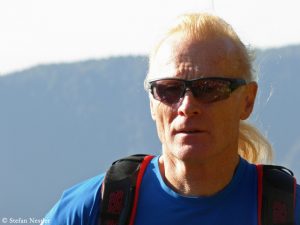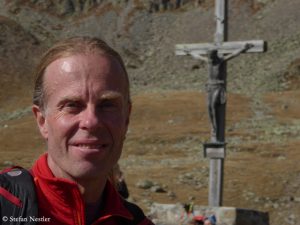Alexander Polli: “I’m extremely afraid of dying”
The dream of flying like a bird is as old as humanity itself. Until the moment of deploying the parachute a basejump from a cliff seems to get close to this dream, jumping with a wingsuit from a mountain maybe even closer. But there’s a catch: Mostly a mistake means death. In 2013 alone more than twenty jumpers died, among them the Canadian Mario Richard and the Briton Mark Sutton. The 47-year-old Richard was the husband of US climber Steph Davis. The 42-year-old Sutton had served as a stunt double of James Bond during the opening ceremony of the Olympic Games 2012 in London when he had skydived out of a helicopter into the Olympic Stadium. Both died in August during wingsuit flights, Richard in Italy, Sutton in Switzerland.
During the International Mountain Summit in Brixen I talked to Alexander Polli. The 28-year-old Norwegian, who is living mostly in Italy, is one of the most experienced wingsuit flyers of the world. This year he caused a furore by flying through a rockhole in Spain with about 250 km/h.
Alex, some say it’s crazy, you risk your life. For what?
I don’t necessarily see it so much of risking my life because I’ve taken so much time in preparation in what I’ve been doing. I did 1500 skydives in two years before I did my first basejump. That allowed me to gain a level of training that when I’m jumping off the cliff it’s not a question if I can fly. I’m sure I can fly. I’ve never seen it as risking my life. Honestly, I’m extremely afraid of dying. I’m extremely afraid of heights. What made me able to do this was that I wasn’t the first. There were other skydivers and basejumpers who had been doing it for twenty years. So in my eyes it was always like: Why can they and why can’t I? Am I missing something or is it just my fear that is stopping me.
But you continue to do it. What do you get from it?
I was just jumping the other day, from Mt. Brento. I had the honour of jumping with father and son. The father is 61, the son was my age, 26, and we were all jumping together. Still now, when I’m standing up there and you are standing in this wingsuit, first at one point you might feel a little bit silly. Like: What am I doing? Am I an idiot or what? And then after it you realize what you are about to do, the fact that you are very comfortable because you have all the training. And, oh my God, I’m going flying down the mountain! So even when you land and you look back up from where you came from, like when I was watching the video tonight playing on the big screen, it’s kind a like “Wow, is that me? Was that really me?” I mean it true, here is a dream becoming reality.
Alexander Polli: Dream is becoming reality
But is it your goal to get nearer and nearer and nearer to the rock?
No, that’s definitely not the goal. It’s great to fly close to stuff because you get a good visual of how fast you’re going. My goal is more the missions. I meet up with friends and we go up to big cliffs that have potentially sometimes never been jumped before or I have never jumped before. Me not being a climber necessarily. The mission to get up there, that little bit of climbing that for these people we have around us here at IMS is nothing, for me is horrifying, terrifying. It’s a lot more scarier than the jump when I finally stand at the edge with the parachute. I’m like finally I’m safe. It’s the going up part that is scary and dangerous.
But there are major debates because there have been many casualities recently. Many of your colleagues died. What would do you answer these critics?
My answer would be: It’s truly a very new sport. Our understanding of how the wingsuits fly is still very limited. The way that we are taught, the way that somebody who has more knowledge would teach somebody that has less knowledge is very kind of “Put your finger in the air and let’s see what works!” There is no true science to it. These wingsuits just came out eight years ago.
Alexander Polli: Our knowledge is very limited
I feel great honour and joy to have been able to meet some of these people that aren’t with us any more. I feel that some have been unlucky and some casualities are really due to meteorological conditions. All these wingsuit flyers were not necessarily paragliders. So we don’t real understand thermics and so forth. But more and more I have been involved in the sport more and more I realize that thermics actually have a lot to do with what we do in wingsuits. Because if you have the heat that’s coming off from the mountain you’re gonna be able to fly that far. If the mountain is in the shadow you are not gonna be able to fly that far. But maybe you don’t even think about this before you’re jumping. So I think, because it’s such new sport just our knowledge is very limited.
Your videos are very spectacular. Millions of young people are watching them. Do you think you have a responsibility for these people. Maybe they say: “Wow, I also wanna do this!”, and they try it without the skills they need.
Indirectly yes. I would like to say no, I don’t because being responsible in that way seems like a very big word and tough thing to take in my plate. But yes, I have potentially inspired or woken somebody up to potentially want to wingsuit one day while if they didn’t see that video they won’t. This is one of the reasons why this year you will not be seeing a new cave jump or a new reality of human flight like I have been releasing the last year. What you will see this year is something by me for the jumpers, speaking about state of mind – and specific guidelines. If you would include these rules, if you would impose yourself these rules, “Okay, if I jump a wingsuit from the mountain I will never do this and I will always do this”, then you can really find a way to be able to do this I believe a million out of a million.
Alexander Polli: I feel indirectly responsible
This would be better than regulations?
For sure because regulating something like this is almost impossible. The locations from where you jump, how do you gonna have a little security checkpoint on top of the mountain? “Yes, you can jump! No you can’t!” (laughs)
It’s your passion to do that. Do you think that passion one day will end?
My passion is for a massive amount of adventure, honestly. I think I’ve already been jumping and flying so much that I do want to go climbing more. The climbing really fascinates me. I’m truly very, very challenged, inspired, amazed by these people that actually go up big walls and do that amazing climbs. I think what they do is totally nuts (laughs) compared to what I’m doing. I would like to learn that better. I would like to learn how to surf better. I would like to wild water rafting, trekking over long distances. There are plenty of other adventures that I can find myself really liking.








